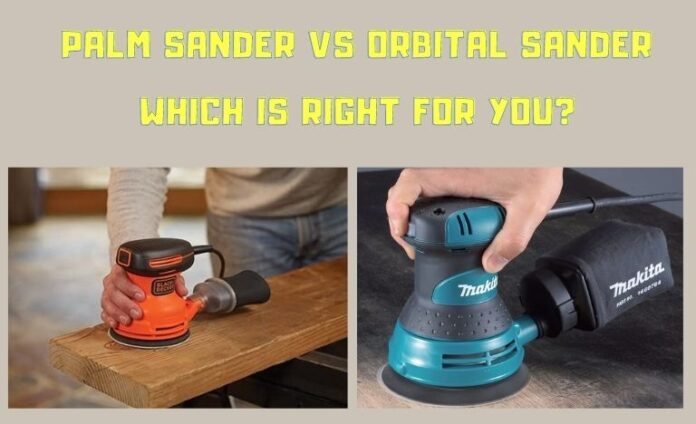If you are remotely familiarized with woodworking, you would have definitely needed to attempt a sanding process at least once in your life. Sanding is one of the final stages of a woodworking project to get a smooth wooden surface. A sander is a tool that uses sandpaper for this purpose, for removing paint, polishing surface, varnish, smoothing wood, etc.
Sanding is a niche job that often ruins woodwork if there’s any mistake, which includes not using the right tool. Sadly, the two common sanders don’t offer any tips on which situations they should be used.
We are here to help you make a judgment. Keep reading to find out about palm sander vs orbital sander.
Palm Sander Vs Orbital Sander: Which One Is Suitable For You
Although sander is a common woodworking tool, it is very easy for a novice to get confused as their descriptions don’t provide much information. Which is why on the surface, they both look the same. The truth can’t be farther away from that as in reality both have differences a woodworker needs to be aware of.
And this is where ToolsLord comes in to save your day, providing you with information on palm sander vs orbital sander and help you figure out what kind of sander is right for you.
But before we get into it, you need to know about the sanders in detail. Let’s start off from there:
Palm Sander
As the name suggests, palm sanders are small and lightweight enough to fit in your hand. They are quite affordable for those with a tight budget. It is perfect for small projects.
Size
They are the smallest sanders meaning they’re good with precision. So, work which needs fine sanding and smooth finishing, palm sanders are a better choice. Quarter sheet sized sander is more precise.
Power
Palm sanders mostly use a 2.0amp motor. Usually, small scale woodworking doesn’t need to go any higher 3.0amp motor.
Sandpaper
This type of sander uses a 160-220 grit range, making it an ideal sander for light jobs like smoothening a surface.
Grip
Since palm sanders are made to be lightweight, it is quite delicate to touch and for that reason, you need to be careful about using force so that you don’t push hard and wear out the pads.
Dust collection
This is one of the drawbacks of the palm sander. They are not as good as orbital sanders in this aspect. Therefore, you’d want a dust bag with a proper seal on it.
Orbital Sander
Orbital sanders are square in shape and work in by spinning discs in orbits. Due to their square shape, they can work with corners and edges better. Orbital sanders can deal with bigger surfaces easily. But because it leaves a swirl, it looks bad on unpainted wood. For that reason, orbital sanders are best used in woods that are prepared for being painted or varnished.
Power
Common orbital sanders use 2.5-3.0 amp, some even use 5.0 amp.
Speed
Orbital sanders come with a standard 10,000 orbits per minute rate. The faster speed is usually better for the larger piece of wood, however too fast could make it go out of control.
Sandpaper
Orbital sanders use 80-160 grit range sandpaper.
Grip
The tool needs to continuously move, so you have to be careful otherwise it would dig into the wood. Typical orbital sanders move with one hand, but modern models have room to use two hands with different kinds of handles.
Now that we have cleared out a detailed explanation, time for a head to head comparison.
The differences between a palm sander and orbital sander
- Palm sanders are for light jobs whereas Orbital sanders are heavy duty.
- Palm sanders require less power than orbital.
- Orbital sanders are faster at getting the job done.
- Palm sanders provide smoother results.
- Palm sanders are more precise.
- Palm sanders usually cost around 50$ while Orbitals are around 100$, making palm sander more affordable for a casual small-scale DIY worker.
- Orbital sanders can fit in corners easily thanks to their shape which palm sanders can’t access.
- Palm sander doesn’t leave swirls like Orbital sanders
- Palm sanders are not good with a large-sized wood; you need an orbital sander for that.
- Palm sanders can be used as polishers; Orbital sanders aren’t suggested for this kind of work.
- Orbital sanders are better suited for drywall.
- Orbital sanders are better suited for decking.
Conclusion
Each sander has its own pros and cons which they bring to a woodworking place, it is up to its masters to decide what their priority is. Is the holder of the sander a woodworking maniac or a casual DIY enthusiast with neat and clean operations?
The answer to that question is with YOU. If you got an answer to that and you diligently followed our palm sander vs orbital sander guide, you are well equipped to choose. Happy woodworking!




















